The grain of the month for July is oats. Oats are sweet, earthy-flavored grains. They are cholesterol free, typically easy to digest, and provide a great source of protein.
I had some oat flour that I wanted to experiment with so I adapted the Seeded Oat Bread recipe from Healthy Bread in Five Minutes to include rolled oats as well as oat flour. Oats do not naturally contain gluten* so flour made from oats needs to be mixed with white or whole wheat flour for yeast breads.
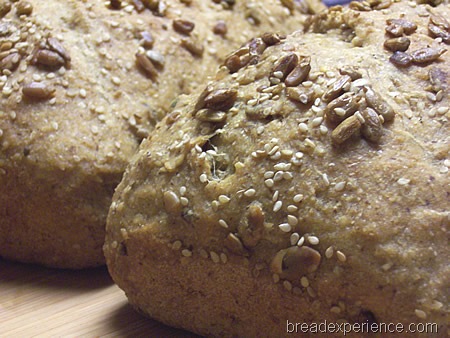
Make Your Own Oat Flour
Oat flour is ground from the endosperm. I got my oat flour from the farmer’s market, but you can make your own oat flour by processing 1 and 1/4 cups rolled oats in a food processor until finely textured. This will yield 1 cup. The flour will be a little coarser than commercial oat flour but will still work in this and other recipes.
*Note: Although oats don’t naturally contain gluten, it can be introduced during the milling process or through accidental cross-pollination with wheat or rye. If you have a sensitivity to oats, please follow the advice of your medical advisor.
Seeded Oat Bread with Oat Flour
Adapted from Healthy Bread in Five Minutes by Jeff Hertzberg and Zoe Francois
Yield: 2 loaves
Ingredients:
- 1 cup oat flour
- 2 1/4 to 2 3/8 white whole wheat flour
- 2 3/4 cups all-purpose flour
- 1 cup old-fashioned rolled oats
- 2 tablespoons ground flaxseed
- 3/4 cup pumpkin seeds, plus more for sprinkling on top crust (if desired)
- 3/4 cup sunflower seeds, plus more for sprinkling on top crust
- 1/4 cup sesame seeds, plus more for sprinkling on top crust
- 1 1/2 tablespoons granulated yeast, or 2 packets
- 1 tablespoon kosher salt
- 1/4 cup vital wheat gluten
- 3 cups lukewarm water
- 1/2 cup barley malt syrup, honey, or agave syrup
- 1/4 cup neutral-flavored oil
Directions:
Mix together the flours, rolled oats, seeds, yeast, salt, and vital wheat gluten in a large bowl using a whisk or a wooden spoon.
Add the liquid ingredients and incorporate them completely into the dry ingredients using a Danish dough whisk.
Cover the bowl (or container) and allow the dough to rest at room temperature until it rises and collapses, about 2 hours. Refrigerate the dough for at least 24 hours and up to 7 days.
When you’re ready to bake, remove the dough from the refrigerator and shape it into a ball. Let the ball rest for about 5 minutes, then elongate the ball into an oval shape and place it in a lightly greased nonstick loaf pan. Cover loosely and let the loaf proof for an hour and 45 minutes.
Preheat the oven to 350 degrees F. Just before baking, spray the loaf crust with water and sprinkle the top with seeds. Slash the loaf diagonally with 1/4-inch-deep parallel cuts, using a serrated bread knife.
Place the loaf on the middle rack in the oven. Let it bake for about 40 minutes, until browned and firm. It will be a pale cream-colored due to the rolled oats and oat flour.
Remove the bread from the oven and let it cool completely on a wire rack before serving.
This bread is interesting. It has a nutty flavor due to the seeds and oats. It tasted good as a PB&J and it’s very filling.
Bob’s Red Mill launched its first ever “Spar for the Spurtle” Porridge Making Contest this month so this compelled me to do some experimenting.
All in all I think my Seeded Oat Bread experiment was a success, but it could be improved. The texture was not too coarse or crumbly so I believe the proportion of oat flour relative to the other flours works. However, I didn’t roast the pumpkin seeds and I could tell the difference in flavor. I would definitely do that next time to enhance the flavor of the seeds. I would also use honey instead of barley malt. It needed a bit more sweetness to offset the flavor of the oat flour and the seeds.
This bread has been YeastSpotted. Please visit Wild Yeast to view all of the lovely breads in the roundup.
Happy Baking!
Cathy
About the HBinFive Baking Group
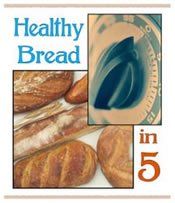
The HBinFive Baking Group, started by Michelle of BigBlackDog, has been baking through all of the breads in the Healthy Bread in Five Minutes book.
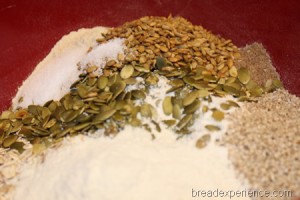
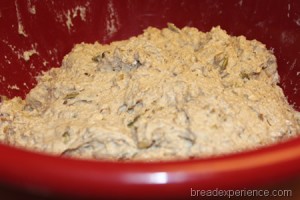
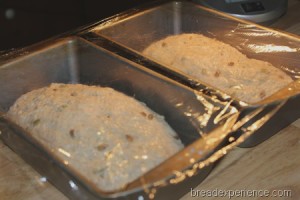
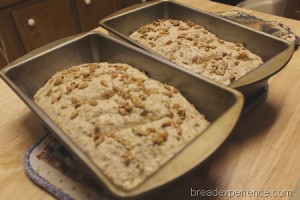
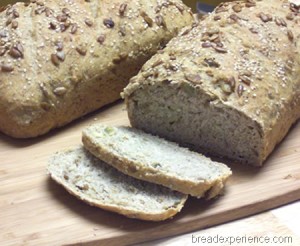
Tanya says
That bread looks delicious. I’ve gotta try it!
Emily says
Why does the dough need to be refridgerated after the first rise and before baking?
Cathy (breadexperience) says
Hello Emily,
This is a no knead bread so the dough is refrigerated to develop the gluten structure and improves the flavor. You can use it after the initial 2-hour rise, but it’s much easier to work with and has better flavor if you refrigerate it overnight.
Thanks,
Cathy
Sherry says
HI Cathy,
You mention for yeast in this recipe to use 1/4 cup vital wheat gluten, What is this and is it necessary to use? Ive been skipping the recipes with this ingredient since i wasnt sure about it. Ive just started baking breads and love your website and recipes! Thanks, Sherry
Cathy says
Hi Sherry, I’m so glad you’re enjoying my site and the recipes. Vital wheat gluten is a powder which is sometimes added to breads to help them rise, particularly when incorporating lower gluten flours. I included it in this recipe because this was the method from the book; however, I don’t typically use vital wheat gluten anymore. I rely on the slow fermentation to develop the dough. It probably isn’t necessary for this bread because it includes a fair amount of white flour which will provide the dough with strength. Hope this helps. Happy Baking!